Obituary of Anado McLauchlin
News Category: News, Community News, and People of SMA
-
by Sheridan Sansegundo
Anado McLauchlin, whose art brought joy and color into the lives of so many people, died at La Casa de las Ranas in La Cieneguita on Easter Sunday. He was 73.
In 2001, Anado and his husband, Richard Schultz, moved from San Francisco to San Miguel de Allende. Because they wanted dogs and cats and donkeys, they bought a house in La Cieneguita on two acres of mesquite-covered hillside.
The house was an ugly duckling. To see photos as it was then, and then to see it transformed over the years into the joyous lollapalooza of color and tile and bottles and weirdness listed by TripAdvisor as the #1 place to see in San Miguel is to shake one’s head in amazement.
With the help of his assistant, Carlos Ramirez Galvan, and other members of Carlos’s Chichimeca family, the pace of the transformation never slowed and never failed to enchant. The wall of dogs arrived, the wall of snakes, the phantasmagorical self-composting privy, the reds, the purples, the mirrors, the Virgin of Guadalupe in her bathtub niche.
In 2012, the Chapel of Jimmy Ray Gallery, built down the hill from the house, had its inaugural show—photographs by Spencer Tunick—and since then has had regular exhibitions by artists who shared Anado’s offbeat nonconformist sensibility.
Anado and the property were extravagant, and so too were the gallery openings. There were singers and dancers and mojigangas and fireworks. A young, mostly unclothed, experimental theater group from Mexico City performed. Actors arrived on donkeys. The crowds moved up and down the staircase, grasping the 30-foot bejeweled anaconda handrails, transported to a wilder, more colorful world.
Anado was born James Rayburn McLauchlin, III in Oklahoma on May 24, 1947, the third child and only son of Marie and James Rayburn McLauchlin, Jr. He went to Catholic school and later to the University of Oklahoma. Being gay and naturally rebellious, it was not always a smooth ride. In 1967 he was drafted into the Navy and spent time in Vietnam and, in contrast, was in San Francisco for the “summer of love.”
Finally out of the Navy he returned to Oklahoma City, where he opened the first and only head shop in the city and got himself arrested for selling the comic book “Zap.” But Oklahoma City wasn’t going to cut it, and like so many other young gay men before him, he moved to New York City, working as a powder monkey and at the Stage Deli before becoming a taxi driver, so he could compose his beat poetry while he was driving. He read that poetry, as wild and colorful as his art, at CBGBs, St. Mark’s Place, and on stage at the Gay Pride march with Patty Smith and Lou Reed.
In the late ‘70s he opened his heart, his spirit and his trust to the Indian guru Bhagwan Shree Rajneesh, a college professor and spiritual teacher (also referred to as the Sex Guru). He was offered and took the name Anand Anado, which means Blissful Silence. He then left New York for the Rajneesh Ashram in Pune, India.
The exotic life in India—the colors, the food, the burning ghats, the smells, the animals, the crowding, the poverty, the temples, the beggars, the caste system, all tweaked Anado’s perceptions. His thinking altered, he said, opening his eyes to a deeper expanded universe….and he loved it. He found love, sex, awareness and connection. He became an ‘ever-evolving’ personality and spiritual seeker, reveling in the process and loving the ride.
When he returned to New York City, he met his friend Michael Sudheer and they joined Bhagwan and the spiritual community on the west coast. Rajneeshpuram was a live-off-the-land experiment built on the eastern slope of the Cascade Mountains. Long days of hard physical labor and careful planning converted the semi desert into a lush setting for a large community of consciously living individuals. In spite of all good intentions, human frailties and warring egos caused the dissolution of the project amid scandal and lawsuits just six years after its inception.
Anado returned to San Francisco, where he opened an award-winning landscape gardening business called Mother Nature and Son (his clients included members of The Grateful Dead) and began concentrating on his art. In 1998, he met Mr. Schultz, a teacher of art history, who became the calm at the center of Anado’s storm. Their wedding was on a hillside in Mill Valley, Marin County, overlooking the San Francisco Bay.For someone with his gargantuan appetite for life Anado unabashedly loved to be the center of attention. And because he usually dressed like some wild, pagan garden, he usually was. Wherever in the world the couple went, people stopped to ask for selfies with them. Sometimes, it’s true, it was because they were mistaken for ZZ Top, but more often the reaction was, “Look at those amazing guys! I wish I had the guts to dress like that!” But however outré and surprising, their clothes always read as style, not fancy dress, just as the extensive mosaic work at Casa de las Ranas was definitely art, not decoration.
Feisty, outrageous, mischievous, but as gentle as a lamb, this creative genius was something to everyone—real or perceived. His friend the artist Edward Swift said, “If anyone had a fulfilling life it was Anado. Yes he had many works of art yet to be created, but he left us with so much.
He was a legend in his own time and his legacy will continue.”In addition to his devoted husband, life partner, companion, and co-artist Richard, Anado is survived by two sisters and his many friends and fellow spiritual seekers. A memorial gathering will be held in August.
”Groove on,” as he would say.
-

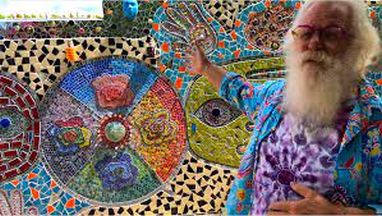
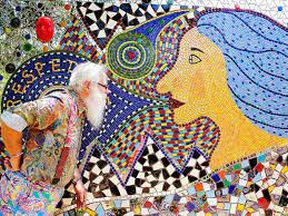
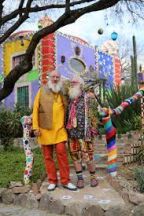
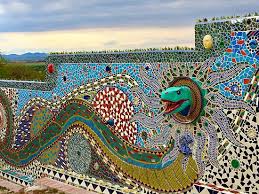
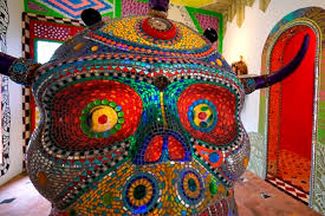
Leave a Reply